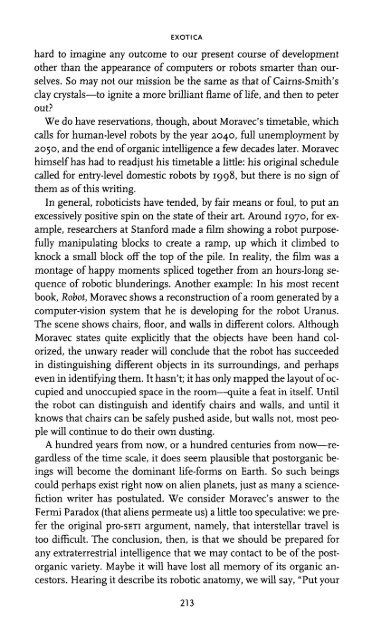You also want an ePaper? Increase the reach of your titles
YUMPU automatically turns print PDFs into web optimized ePapers that Google loves.
THE DEATH AND LIFE OF STARS<br />
duced the warping, however, the hypothesized planet remains just<br />
that—hypothetical. Direct detection of extrasolar planets, where life<br />
might not only originate but evolve and thrive, requires more specialized<br />
techniques, as we'll see in the next chapter.<br />
The disk around <strong>Be</strong>ta Pictoris is now usually described as a "debris<br />
disk," implying that it consists, not of the original gas and dust that<br />
collapsed to form the star, but of material thrown off during collisions<br />
between asteroids, planetesimals, or other objects. While the predominant<br />
infrared radiation comes from micron-sized particles, the disk<br />
may well contain many larger rocky or icy objects. In fact, it may resemble<br />
the Kuiper belt that encircles our own solar system.<br />
So far, the observations on young stars support the notion that planets<br />
form by gradual accumulation of smaller objects within a circumstellar<br />
disk. The disk model also seems to help explain the particular<br />
kinds of planets that we see in the solar system and their relative positions.<br />
There is likely to be a gradient of temperature within a disk,<br />
with the inner regions being hotter than the outer. Thus, within the<br />
inner regions, only rock and metals can condense and form the objects<br />
that later aggregated to form planets. This offers an explanation<br />
of why Mercury, Venus, Earth, and Mars are all relatively small, rocky<br />
planets. In the frigid outer regions, on the other hand, ices can also<br />
condense, adding greatly to the mass of the planets forming there.<br />
Those planets are also able to grow larger simply by virtue of their<br />
longer orbits, which contain more material available to be swept up.<br />
And once past a certain mass, the outer planets can attract and hold<br />
onto a dense atmosphere of hydrogen and helium, derived from the<br />
disk. This is why the outer planets—Jupiter and Saturn especially—<br />
became the solar system's "gas giants."<br />
Is this, then, the pattern we should expect to see repeated over and<br />
over again across the galaxy Are myriad suns surrounded by clones of<br />
our own solar system Gazing at the night sky from the dome of the<br />
Hale telescope at Palomar, we can only ponder the question, as so<br />
many have pondered before us. But technology is finally closing in on<br />
the answer. Part of that technology lies housed below us in the darkness:<br />
the Palomar Testbed Interferometer, the prototype for an astronomy<br />
of the future, hugs the mountaintop like a colossal three-legged<br />
spider. Within its hublike central building, technicians are putting<br />
starlight through an optical maze, hoping to squeeze celestial secrets<br />
out of it.<br />
107













